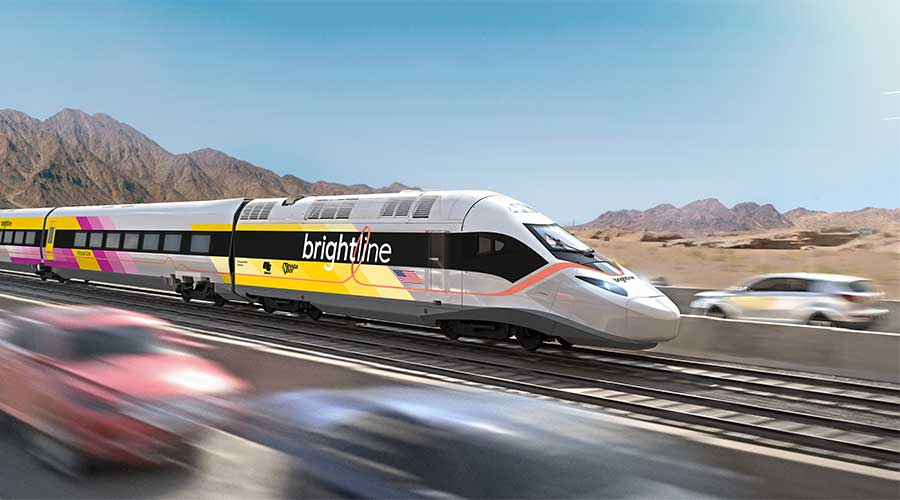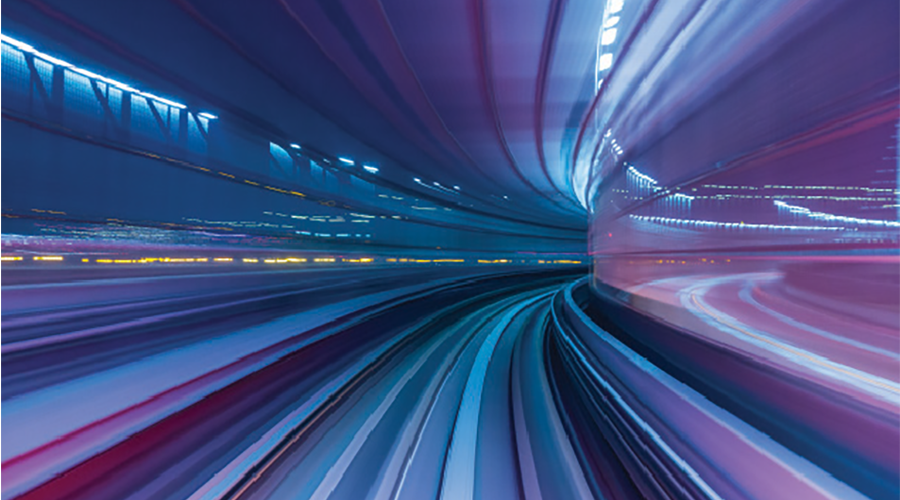Stay updated on news, articles and information for the rail industry
October 2015
Part 1 : Progressive Railroading's Passenger Rail at a Glance 2015: Preface
Part 2 : Progressive Railroading's Passenger Rail at a Glance 2015: Amtrak and transit agencies in Arizona & California
Part 3 : Progressive Railroading's Passenger Rail at a Glance 2015: Colorado, Florida and Georgia
Part 4 : Progressive Railroading's Passenger Rail at a Glance 2015: Illinois and Missouri
Part 5 : Progressive Railroading's Passenger Rail at a Glance 2015: New Jersey, New York, and Ohio
Part 6 : Progressive Railroading's Passenger Rail at a Glance 2015: Oregon and Pennsylvania
Part 7 : Progressive Railroading's Passenger Rail at a Glance 2015: Texas
Rail News: Passenger RailProgressive Railroading's Passenger Rail at a Glance 2015: Amtrak and transit agencies in Arizona & California
AMTRAK
The United States' intercity passenger railroad, formed in 1971.
Route miles: 21,300-plus miles intercity rail
Rolling stock: More than 400 locomotives and 1,500 rail cars, and 20 Acela train sets, plus 70 ACS-64 electric locomotives on order from Siemens, scheduled to be delivered through 2016
Annual ridership: 30.9 million (FY2014)
Number of stations: 500-plus
Major Amtrak-led projects include the Hudson Yards project, designed to preserve a possible pathway for future Hudson River tunnels from New Jersey to New York Penn Station, and the New Jersey high-speed rail improvement project to upgrade tracks, signals and electrical systems over a 23-mile section to improve reliability and increase maximum speed to 160 mph.
ARIZONA
Valley Metro
Valley Metro is the regional public transportation agency providing multimodal transit options to residents of greater Phoenix. Valley Metro plans, develops and operates light-rail and bus systems, and alternative transportation programs.
Light-rail service launched: 2008
Route miles: 23
Rolling stock: 50 LRVs, average age 5.5 years
Annual ridership: 14.3 million
Annual operating cost: $31.2 million
Annual capital cost: $202 million
Number of stations: 32
Major capital projects include:
• Northwest Phase I, a 3.2-mile light-rail extension that will serve an average of 5,000 new riders per day. Construction is being completed by a joint venture between Sundt Construction and Stacy and Witbeck Inc. Total project cost: $300 million, which comes from local and county sales tax revenue. Scheduled to open in spring 2016.
• The 1.9-mile Gilbert Road light-rail extension, which will extend light-rail service in Mesa, Ariz., by 2018. Total project cost: $161 million. A request for proposals for contractors has been issued.
CALIFORNIA
Bay Area Rapid Transit (BART)
BART is a heavy-rail system serving the San Francisco Bay area.
Service launched: 1972
Route miles: 104
Rolling stock: 669 rail cars (average age 40). On order: 775 new cars to be manufactured by Bombardier. Expected delivery: 2021
Annual ridership: 127 million
Annual operating cost: $599 million
Annual capital cost: $711.5 million
Number of stations: 45
BART's major capital improvement projects underway or slated to begin over the next year include the Warm Springs Extension, a 5-mile extension south toward Fremont; and the East Contra Costa BART Extension Project (eBART), which will introduce a new passenger-rail service comprising 10 miles of new track between the existing Pittsburg/Bay Point BART Station and the city of Antioch. The project will use independently propelled rail cars known as diesel multiple units (DMUs) that will operate on standard gauge rail.
Caltrain
Caltrain is a California commuter-rail service between San Francisco and Gilroy, Calif. It runs 92 weekday trains, 36 Saturday trains, 32 Sunday trains and serves 32 stations. It is governed by the Peninsula Joint Powers Board, which consists of board members from the city and county of San Francisco; San Mateo County Transit District; and the Santa Clara Valley Transit Authority. Caltrain is operated by Transit America Service Inc.
Service launched: 1992
Route miles: 77
Rolling stock: 29 locomotives, average age 25 years; 134 rail cars, average age 23 years
Annual ridership: 18,567,173 (FY2015 YTD)
Annual operating cost: $125,736,026 (FY2015 budget)
Annual capital cost: $43,554,725 (FY2015 budget)
Number of stations: 32
Projects underway or scheduled to begin include:
• The Communications Overlay Signal System (CBOSS) Positive Train Control (PTC) project, an advanced signal system that will equip the corridor with federally mandated safety technology and will increase system capacity to help accommodate future increases in ridership.
CBOSS PTC will be interoperable with all other rail systems that access the Caltrain corridor, including commuter rail, freight rail, and, in the future, high-speed rail. Estimated to cost $231 million, the project is a key component of the Caltrain Modernization Program. Revenue service demonstration is expected by December, with final system acceptance by June 2016. Primary contractor is Parsons Transportation Group.
• The $200 million Quint Street Bridge replacement, which involves removing a century-old bridge and replacing it with a new berm, which will be designed to allow for a potential Caltrain station to be located at Oakdale Avenue. Work is slated to begin this month. Shimmick Construction is the contractor.
• The $38 million San Mateo bridge replacement project. In cooperation with the city of San Mateo, Caltrain is preparing to replace four rail bridges in the city’s North Central neighborhood. Located at Tilton, Monte Diablo, Santa Inez and Poplar avenues, the project will require raising track height throughout the area, and the construction of new retaining walls and fencing on the Caltrain right of way. The four bridges will be replaced with single-span structures to comply with federal and state seismic safety standards. Street closures to accommodate construction began this year; the overall project’s completion is expected in August 2016.
• Los Gatos Bridge replacement, in cooperation with the city of San Jose. The project will include installation of a tail track south of the San Jose Diridon station, which will provide improved operations at the station, minimize system delays and facilitate Caltrain’s modernization, including the corridor’s electrification. The new bridge will be a pre-stressed, pre-cast concrete structure with new foundations and a widened deck. Box girders will support three spans, each totaling 175 feet long and 35 feet wide. Total cost: $31.8 million. Contractor for design is HDR; construction is yet to be determined.
• Peninsula Corridor Electrification (PCEP), which will electrify the Caltrain corridor from San Francisco’s 4th and King Station to the Tamien Station; convert diesel-hauled trains to electric multiple unit (EMU) trains; and increase service to six Caltrain trains per peak hour per direction. The PCEP is a key component of Caltrain’s modernization. A request for proposals was issued to six prequalified teams in February; an award is expected in November. Cost: $1.5 billion. Revenue service is anticipated for 2020.
Los Angeles County Metropolitan Transportation Authority (Metro)
Metro serves as transportation planner and coordinator, designer, builder and operator for Los Angeles County, where 9.6 million people live and work within its 1,433-square-mile service area.
Service launched: Light rail, 1990; heavy rail, 1993
Route miles: Light rail, 69; heavy rail, 17.4
Rolling stock: Rail cars, 104, average age 17.7; LRVs, 171, average age 15.5. Seventy-eight LRVs are on order (with option of up to 235), which are being manufactured by Kinkisharyo.
Annual ridership: Light rail, 62,775,098; heavy rail, 47,724,495
Annual operating cost: $370.2 million
Annual capital cost: $1.7 billion
Number of stations: Light rail, 64; heavy rail, 16
Metro's major rail-related capital improvement projects underway or scheduled to begin in the next year include:
• Exposition Transit Corridor Phase II, which will extend the light-rail Expo Line from its current terminus in Culver City to Santa Monica. Total project cost: $1.5 billion. Contractors: Skanska/Rados Expo 2 Joint Venture, mainline; Kiewit Building Groups, Operations Maintenance Facility. Timeline: under construction; revenue service scheduled for 2016.
• Gold Line Foothill Extension Phase 2A, which involves extending the light-rail Gold Line from its current terminus in Sierra Madre to Azusa. Total project cost: $741 million. Contractors: Foothill Transit Constructors (a Kiewit/Parsons Joint Venture) for the Mainline and Operations Maintenance Facility. Under construction; revenue service scheduled for 2016.
• Crenshaw/LAX Transit, which involves construction of a new light-rail line from the existing Metro Exposition Line at Exposition/Crenshaw and travel 8.5 miles South/Southwest to connect to the existing Green Line at Aviation/LAX. The project includes eight stations and a maintenance facility. Project cost: $2 billion. Contractors: Walsh-Shea Corridor Constructors and Hensel Phelps/Herzog. Under construction; revenue service scheduled for 2019.
• Regional Connector, a 1.9-mile underground segment of light rail to run through downtown Los Angeles, connecting the Gold Line to the 7th Street/Metro Center Station and resulting in direct connections between Azusa and Long Beach, and East Los Angeles and Santa Monica. Cost: $1.5 billion. Contractors: Skanska-Traylor Regional Connector Constructors Joint Venture. Under construction; revenue service scheduled for 2020.
• Westside Purple Line Extension, which will extend the heavy-rail Purple Line from its current terminus in Koreatown (Wilshire/Western station) 9 miles west to a new terminus in West Los Angeles. The project is being built in three phases, with the first phase consisting of 3.9 miles to Wilshire/La Cienega. Cost: $3.15 billion (Phase I). Contractors: Skanska, Traylor Brothers Inc. and J.F. Shea Construction Joint Venture (Phase I). Under construction, with Phase I revenue service scheduled for 2024.
• The acquisition of 235 light-rail vehicles. Cost: $890 million. Contractor: Kinkisharyo. Initial delivery of 78 LRVs by 2017.
San Francisco Municipal Transportation Agency (SFMTA)
Established by voter proposition in 1999, the SFMTA, a department of the city and county of San Francisco, oversees the Municipal Railway (Muni), parking and traffic, bicycling, walking and taxis. With five modes of transit, Muni has 700,000 passenger boardings each day.
Service launched: 1912 (light-rail streetcar)
Route miles: 71.5 (light rail)
Rolling stock: 151 LRVs, average age 15; more than 200 LRVs on order with expected delivery to start in 2016. Siemens is the manufacturer.
Annual ridership: 51 million
Annual operating cost: NA
Annual capital cost: $1.2 billion
Number of stations: 28
Capital improvements include:
• Sunset Tunnel track replacement, which aims to improve the safety and reliability of the N Judah Line by replacing track and other infrastructure inside the tunnel. Other improvements include transit signal priority upgrades at nine intersections along the N Judah Line and construction of accessible platforms at Judah and 28th Avenue.
• Twin Peaks Tunnel light-rail track replacement along the tunnel’s entirety. The new tracks will allow trains to move faster through the tunnel and improve travel times.
• Central Subway project, which will extend the Muni Metro T Third Line to provide a direct transit link between the Bayshore and Mission Bay areas to SoMa, downtown and Chinatown.
Santa Clara Valley Transportation Authority (VTA)
VTA is an independent special district responsible for bus, light-rail and paratransit operations; congestion management; specific highway improvement projects; and countywide transportation planning.
Light-rail service launched: 1987
Route miles: 42.2
Rolling stock: 99 low-floor LRVs, average age 9, manufactured by Kinkisharyo
Annual ridership: Over 11 million
Annual operating cost: $419 million in FY2016; $423 million in FY2017
Annual capital cost: $589 million in FY2016
Number of stations: 61
VTA's capital projects this year include the 10-mile extension of the Bay Area Rapid Transit (BART) District’s commuter rail from Warm Springs/Alameda County to Berryessa/Santa Clara County. Revenue service for this extension of BART is planned for late 2017.
Major construction contracts include:
• Skanska-Shimmick-Herzog, the design-build contractor for the track, systems and stations has completed construction drawings and construction is in progress. Original contract value: $772,227,000.
• The Milpitas Campus surface parking lot construction contract was awarded to Ghilotti Construction Co. Inc. and construction is underway. Original contract value: $5,357,787.
• The Berryessa Station campus and roadways construction contract was awarded to Granite Rock Co. in August. Original contract value: $26,324,931.
• McCarthy Builders is the design-build contractor for the parking structures contract. Design of the parking structures at Milpitas Station is in progress and Berryessa parking structure construction began in June 2015. Original contract value: $86,851,623.
• The Tasman Drive light-rail pocket track project installed an additional track and supporting infrastructure so one track can be used as a pocket track to store additional cars on Tasman near Old Ironsides Station in the city of Santa Clara. This contract was completed in early 2015. Contractor: Stacy and Witbeck. Original contract value: $13,688,610.
• The Mountain View double-tracking project has been accelerated and is a high priority due to an anticipated increase in ridership for upcoming major events related to the new Levi Stadium in the city of Santa Clara, where Super Bowl 50 will be hosted in February 2016. The project will implement a series of improvements to establish a new line from Mountain View to Alum Rock to connect with Caltrain and the new Milpitas BART Station. Construction under the two construction contracts is ongoing. Shimmick Construction is the prime contractor for Phase I and B&C Transit for Phase II. Contract value for Phase I: $16,703,749; contract value for Phase II: $11,706,985. Completion: December .
• A rail rehabilitation project addresses various track and safety issues throughout the VTA light-rail system. Work includes rehabilitation or replacement of track and crossovers, rail de-stressing, tie replacement and track signal improvements. Shimmick Construction completed all major construction on the current rehabilitation contract in July 2015. Original contract value: $5,865,000. The next rail rehabilitation contract is expected to be issued for bid in early 2016.
Additionally, 2.6 miles of light rail into east San Jose and a 1.57-mile light-rail extension into Los Gatos are on hold until funding is available.
Part 1: Progressive Railroading's Passenger Rail at a Glance 2015: Preface
Part 2: Progressive Railroading's Passenger Rail at a Glance 2015: Amtrak and transit agencies in Arizona & California
Part 3: Progressive Railroading's Passenger Rail at a Glance 2015: Colorado, Florida and Georgia
Part 4: Progressive Railroading's Passenger Rail at a Glance 2015: Illinois and Missouri
Part 5: Progressive Railroading's Passenger Rail at a Glance 2015: New Jersey, New York, and Ohio
Part 6: Progressive Railroading's Passenger Rail at a Glance 2015: Oregon and Pennsylvania
Part 7: Progressive Railroading's Passenger Rail at a Glance 2015: Texas
Keywords
Browse articles on Amtrak Bay Area Rapid Transit Valley Metro Caltrain MetroContact Progressive Railroading editorial staff.


 2025 MOW Spending Report: Passenger-rail programs
2025 MOW Spending Report: Passenger-rail programs
 Gardner steps down as Amtrak CEO
Gardner steps down as Amtrak CEO
 Guest comment: Oliver Wyman’s David Hunt
Guest comment: Oliver Wyman’s David Hunt
 Women of Influence in Rail eBook
Women of Influence in Rail eBook
 railPrime
railPrime








